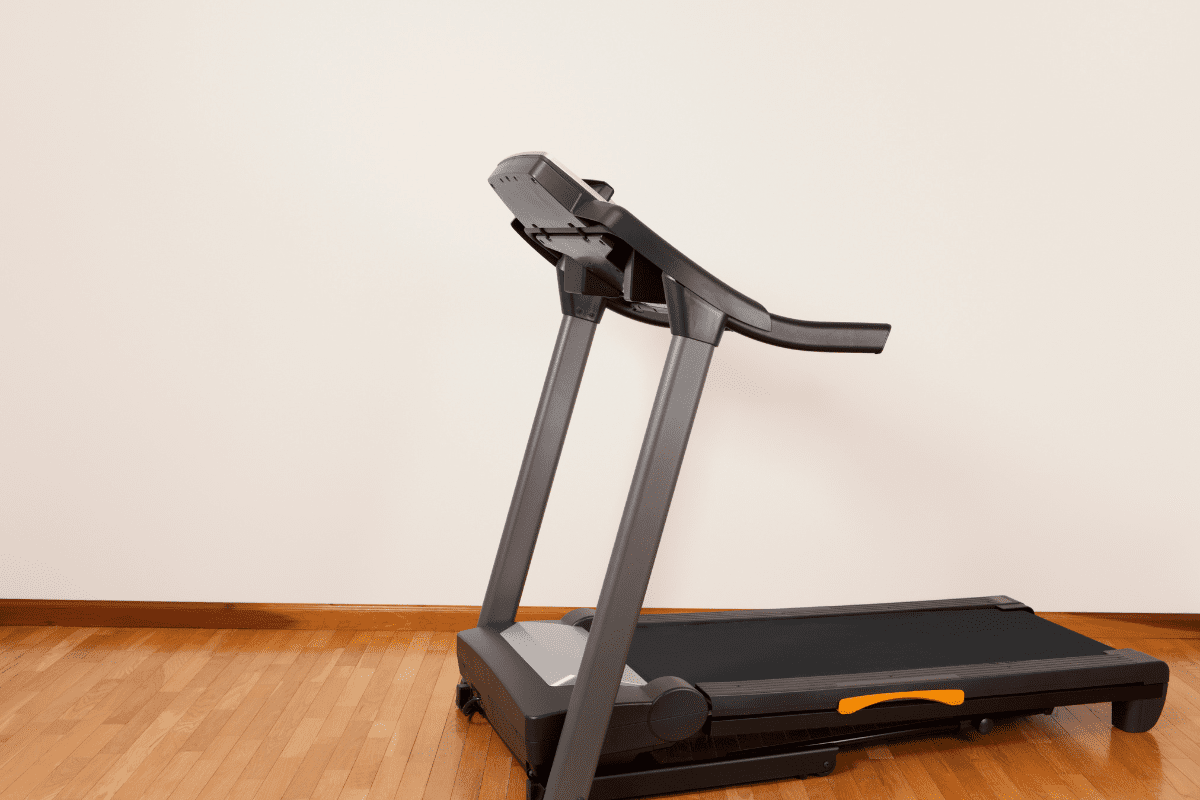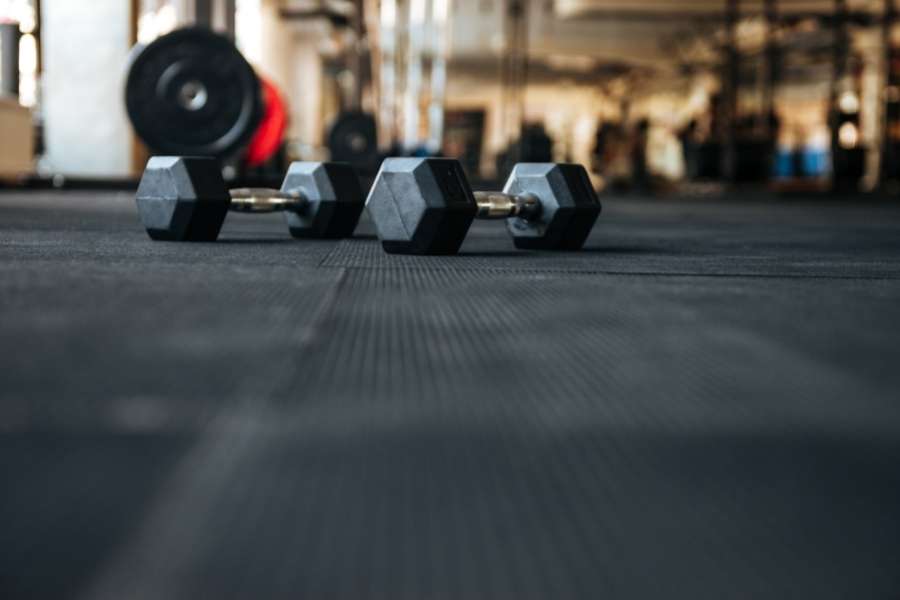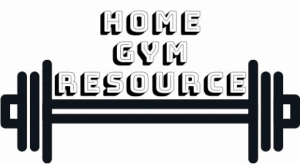Picture this: you’re peacefully jogging on your trusty treadmill, feeling good about yourself. But wait! Could this humble exercise machine secretly be plotting against your beloved flooring? Can a treadmill really wreak havoc on your floors? Let’s dive into this tale of rubber feet, weighty worries, and the mischievous dance of friction!
In general, the weight combined with the slight rubbing of the rubber feet of a treadmill can damage flooring. Some flooring types are more susceptible to damage than others. Protecting your floor from treadmill damage is very easy to do.
To protect your flooring from potential damage caused by a treadmill, there are several options you can consider. One option is to use larger rubber or foam feet to spread out the weight and reduce pressure on the floor. Another option is to use a treadmill mat, specifically designed to provide a barrier between the treadmill and the floor, absorbing shocks and preventing rubbing damage. Let’s get into which type is best for your home gym.
| Flooring Type | Potential Problems | Recommended Solutions |
|---|---|---|
| Carpet | Rubbing damage and wear over time. | Use larger rubber or foam feet under the treadmill. |
| Use a treadmill mat designed to absorb shocks and prevent rubbing damage. | ||
| Cork | Dents and scratches. | Place cork tiles or coasters under the treadmill feet. Rubber or vinyl mats also work. |
| Concrete | Minimal damage unless dropped from a significant height. | Use a mat for extra grip and to prevent dirt and dust from entering the treadmill’s motor and electronics. |
| Tiles | Risk of tile breakage due to weight and rubbing. | Add protective padding under the treadmill feet. Any Material will work, rubber is good. |
| Hardwood | Scuffs and scratches on the lacquered finish. | Use cork tiles or mats to protect the floor. Rubber and vinyl could stain the wood. |
| Laminate | Light scuffs from treadmill feet rubbing. | Consider adding protective padding for extra protection. Any type of padding works. |
| Vinyl | Dents and dullness from weight and rubbing. | Use a treadmill mat or other protective padding. |
| Gym flooring | N/A (Already designed to protect the floor and equipment). | Ensure the gym flooring material is appropriate for treadmill use. |
| Other Types | Consider specific wear resistance and load limits of flooring. | Assess the need for protective measures like larger feet or a treadmill mat. |
Contents
Can a Treadmill Damage Flooring?
Is your treadmill causing damage to your flooring? The answer depends on several factors, including the type of floor, the treadmill itself, and how you use it. Let’s delve into whether a treadmill can indeed harm your floor.
In general, there are a few key factors that can potentially harm your flooring:
- Weight: Excessive weight can place stress on the floor’s surface.
- Impact: High-impact activities can lead to damage over time.
- Rubbing: Constant friction can wear down even the toughest surfaces.
So, let’s break down how a treadmill fits into these categories:
Weight: Treadmills are relatively heavy, though not usually heavy enough to cause direct damage. Think of them as being akin to a large wardrobe or similar heavy furniture. The impact of their weight can vary depending on the type of flooring. Some surfaces can withstand it, while others may not. Dented floors are definitely a possibility although most of the time it’ll bounce back when the weight is removed.
Impact: Running on a treadmill does create some impact, but it’s typically not significant enough to pose a major concern. If you can comfortably run on your floor, the impact from treadmill use should not be a significant issue. Most modern treadmills are designed to absorb a substantial portion of the impact when you land on the deck.
Rubbing: Here’s where the potential for damage lies. Continuous rubbing, over time, is what wears surfaces down. This is akin to how tires on a car wear out. While the feet of a treadmill don’t move as much as car tires, the principle is similar. Prolonged rubbing, combined with the treadmill’s weight, can indeed lead to damage. However, this isn’t an immediate or overnight occurrence; it happens gradually.
The extent of potential damage also depends on usage. The more frequently you use the treadmill, the greater the amount of rubbing, and consequently, the faster wear and tear can occur.
Looking for a good spot to put your treadmill? Click here for a breakdown of the best places.

Suggested post: Why do you need gym flooring?
Types of flooring and Treadmill Compatability
If a treadmill can damage your floor mainly depends on the type of flooring you have. There are some differences between treadmills but the surface you put them on makes the biggest difference. Different types of flooring have different wear resistances and load limits.
Let’s take a look at all the different types of flooring and how susceptible to damage they are.
Do Treadmill Damage Carpet?
Placing a treadmill on carpet is a topic that often leaves people with questions. It’s a bit of a gray area, and folks wonder if it’s a good idea. However, this post is all about the potential damage to your flooring, so let’s explore what happens to your carpet when you introduce a treadmill into the mix.
Treadmills can damage carpet through friction. The dents will likely bounce back but the friction can leave a worn spot.
Picture your treadmill as something akin to a hefty piece of furniture. Its weight is distributed to the floor through four feet, and these feet are usually not too big, which means there’s a lot of pressure concentrated in one spot.
When you place a heavy piece of furniture, like a sizable sofa, on carpet, it tends to leave dents. However, over time, these dents often bounce back, and your carpet looks fine again.
Now, here’s where the treadmill situation gets a bit trickier. Unlike a wardrobe, a treadmill generates more vibration and rubbing. So, while the weight by itself might not be a huge concern, when you factor in the rubbing action, it can potentially lead to damage to your carpet over time. It won’t happen overnight, and it varies based on how frequently you use your treadmill and the quality of your carpet.
In essence, putting a treadmill on carpet can indeed result in damage to the carpet, but it’s a gradual process. Once those dents bounce back, your carpet may not appear too shabby, but there will likely be more wear and tear in the spots where the treadmill’s feet make contact with the carpet.
Can You Put a Treadmill On Cork Flooring?
Cork flooring can behave somewhat similarly to carpet when heavy furniture is placed on it. It has the tendency to form dents, which typically bounce back once the weight is removed. Cork is sturdy but not indestructible; it can deform and acquire permanent dents under heavy loads.
Placing a treadmill directly on cork flooring can dent and scratch the surface.
Another issue that often arises with cork flooring is scratching, and pets, with their hard nails, are common culprits. Treadmills, even though their feet aren’t very hard, can cause a bit of rubbing on the floor. This continuous rubbing has the potential to damage the surface. While it’s possible to reseal cork flooring to address this issue, it does mean extra work on your part.
Given the possibility of permanent dents and surface damage due to rubbing, it’s advisable to use some kind of protective material under your treadmill when it’s placed on cork flooring.
Is Putting a Treadmill on Concrete a Problem?
You’d have a tough time trying to damage a concrete floor with a treadmill, unless, of course, you drop it from an absurd height, like three stories high. Concrete is pretty tough stuff.
Your treadmill actually doesn’t like being on a concrete floor too much. Read more about that here.
Now, if you were to take off the rubber feet from your treadmill, you might end up with some minor scratches on the surface. But don’t worry too much, it’ll likely be just a few scratches. Unless your concrete floors are super fancy and polished to perfection, these minor scratches probably won’t bother you much.
However, if your concrete floor is particularly smooth, the treadmill might decide to “walk” a bit during your runs. The impact of running can actually nudge the treadmill over time. To give it some extra grip, you can place a mat underneath.
Plus, let’s be real, if you’ve got a concrete floor you don’t fuss over too much, it’s probably in the garage or basement. We all keep our homes spick and span, but these places tend to be a tad less pristine. Having a treadmill mat under your machine can do more than just prevent any potential damage—it can also keep dirt and dust from sneaking into the motor and electronics, which could lead to early wear and tear.
In the grand scheme of things, damaging your concrete floor with a treadmill is pretty unlikely. Nevertheless, for the sake of your treadmill’s well-being, it’s still a smart move to use a mat underneath it.

Can a Treadmill Damage Tiles?
Tiles are known for their durability, but they aren’t invincible; they can break, typically due to a sharp impact rather than the kind of rubbing you’d get with a treadmill. However, weight can still be a factor in causing tile breakage.
The question is, does a treadmill weigh enough to break a tile? Well, it depends on a few factors, including the quality of your tiles and where you position the treadmill’s feet on the tile. The tricky part is that you won’t know if your floor can handle it until it’s too late. Surprisingly, sometimes even the weight of a fridge can be enough to break tiles, so a treadmill certainly has the potential to do it.
Another issue with placing a treadmill on tiles is that tiles tend to be quite slippery compared to other types of flooring. This slipperiness can cause the treadmill to move around a bit since its feet may not have enough grip.
Now, add to this the fact that replacing a single tile in a floor can be quite a chore, and it becomes clear that using something underneath your treadmill is a wise choice. It helps protect your tiles from potential damage and prevents the treadmill from sliding around.
Is Hard Wood Affected By a Treadmill?
Hardwood flooring can be a bit delicate, and they require some care and attention. Adding extra maintenance to your plate is probably not something you’re looking forward to.
The main issue here isn’t the wood itself, but rather the finish. Hardwood floors are often finished with lacquer, and if it’s glossy, any scratches become very noticeable. When the rubber feet of a treadmill rub against lacquer, it’s a recipe for scuffs and scratches over time. Sure, you can refinish the wood, but that’s a pretty hefty project that can easily be avoided with a little protection.
Now, you’d have to go to some extremes to actually damage the wood underneath the finish. But dealing with a worn finish is troublesome enough, especially when it’s time to move the treadmill.
However, when you’re thinking about placing a rubber mat on a hardwood floor, exercise some caution. Some antioxidants in rubber can react with certain types of wood finish or lacquer, causing a change in color. For this reason, cork tiles are a safer option to put your treadmill on hardwood floors.
By using cork tiles, you can avoid potential color changes and protect your beautiful hardwood flooring from those annoying scuffs and scratches.
How Laminate Floors Handle Treadmills
Laminate flooring might give off the look of real wood, but it’s important to remember that it’s not the real deal. This distinction has its pros and cons. On the bright side, laminate is much more budget-friendly, but it doesn’t match up to the durability of real wood.
Unlike genuine wood, laminate can’t be sanded down and given a fresh finish once it’s worn. Once it reaches that point, there’s no going back.
However, most laminate flooring is reasonably durable, and a treadmill isn’t hefty enough to cause dents or break through it. The treadmill’s feet might leave some minor scuffs, but nothing too major. If you’re not overly concerned about these minor scuffs, it’s not a big issue. But if you want to ensure your floor remains in tip-top shape after moving the treadmill, a little extra protection goes a long way and won’t break the bank.
The great thing about laminate is that you can often replace just one plank if needed. However, keep in mind that this usually requires taking apart the entire floor, so it’s best to avoid it if possible.
Read more about why you need gym flooring here.
Vinyl Flooring and Treadmills

Just like carpet and cork, vinyl flooring can also develop dents when subjected to the weight of heavy objects. In some cases, if you have something sharp, it’s even possible to puncture the surface.
Thankfully, the feet under a treadmill typically aren’t sharp enough to puncture the vinyl, but they can leave behind permanent dents.
Moreover, vinyl isn’t particularly resistant to abrasion. The shiny surface can quickly lose its luster due to friction, such as that caused by the movement of a treadmill.
While vinyl flooring is generally budget-friendly, if you value keeping your floor looking its best, adding an extra layer of protection is a smart move. It may not be an expensive investment, but it can go a long way in preserving the appearance of your vinyl flooring.
Gym flooring
If you already have gym flooring in the spot you want to put your treadmill, you’re good. Protecting the floor underneath and your equipment is one of the biggest reasons gym flooring is used in the first place.
If you have soft foam gym flooring, you might want to think about putting some rubber down instead. Foam flooring is easily damaged by heavy objects like a treadmill. The soft surface can also cause a slight unstable feeling because the whole treadmill can move a little under pressure. This will disappear when the weight of the treadmill compresses the foam over time. That does mean you’ll be left with a permanent dent in your foam though.
On the other hand, foam tiles are very easy and cheap to replace, so you can just change the few tiles if you want to move the treadmill and everything will be fine.
How to protect your floor from your treadmill
So if you are at risk of damaging your floor or you want to make really sure you don’t damage your flooring, what can you do?
There are a few good options you can look at. Pick what works best for you.
If you want to find the best workout room flooring, click here.
Bigger rubber/foam feet
A treadmill usually comes with rubber feet. However, they are quite small and have to transfer a lot of weight to the floor for their size.
The best way to protect your floor is to spread out the weight. You can spread out the weight by making the feet bigger. You don’t have to take the old ones off, just put something under the feet. The easiest way to do this is get a foam or rubber gym flooring tile. Just a single tile is enough. Then cut it in four pieces (or however many feet there are under your specific treadmill, usually four). Put the pieces under the existing feet.
This makes the weight spread out over a larger surface area so there is less pressure on one piece of floor. There is also less rubbing. Rubbing is the thing that damages flooring, more so than the pressure by itself. The combination of rubbing and pressure is especially damaging.
The extra layer absorbs the rubbing and pressure so that is enough to protect most floors.
Treadmill mat
Ok, a cut up rubber tile is not the best looking option. It’s looks a little messy and that’s not what everyone wants. It would be better to have one piece of rubber that covers the whole area. This looks much nicer.
The most obvious solution is a treadmill mat. Protecting the floor is one reason they are recommended to use under a treadmill in the first place.
Treadmill mats are rubber mats specifically made to put under treadmills. It covers the whole area of the treadmill and a little bit more. What this does to protect your floor is spread out the load and provide a barrier between the treadmill and the floor. This barrier prevents rubbing which can wear through some flooring.
Other than that, a treadmill mat helps absorb shocks, dampens noise, prevents dust from getting into the treadmill and catches your sweat if you’re working out hard.
Gym flooring
If the treadmill is part of a larger home gym, you might as well get gym flooring for the whole room. Gym flooring comes in a lot of shapes, sizes and materials.
Large rubber mats give the best results. They are the longest lasting and look the best. They are a bit harder to fit in a room although there are lots of different sizes available.
Rubber tiles are a good option that is easy to put down and move around if necessary. They last long but don’t look as neat as a rubber mat. It’s hard to put down tiles very neatly.
Foam tiles are cheap and very easy to move around. They look good in the beginning but don’t last that long. They are the softest option. For some situations that’s more comfortable. However, to put a treadmill on, rubber is a better option.
Cork tiles
Rubber is not the nicest looking material to put in your living room. Especially if you’re cutting up a rubber tile. A good option that looks nicer (and is safer on hard wood floors) is cork. You can easily buy a few cork tiles and put them under your treadmill feet.
It can be a bit difficult to buy separate cork floor tiles if you don’t want to buy a large amount. However, cork coasters are easily available in smaller amounts.
Cork coasters will be a bit softer than floor tiles. However, Cork is sturdy and will handle it. It might take a while to settle in but once that has happened, you have a good protective pad under your treadmill.
FAQ
What are the best ways to protect my floor from treadmill damage?
1. Use a treadmill mat: Place a durable and non-slip treadmill mat underneath your treadmill. This helps in reducing the impact, prevents scratches, and provides a protective layer between the treadmill and your floor.
2. Check your floor type: Different floor types may require different precautions. For hardwood or laminate floors, consider using thicker mats or interlocking rubber tiles. For carpeted floors, ensure the mat has a firm grip to prevent movement.
3. Level the treadmill: Make sure your treadmill is properly leveled to distribute the weight evenly. This can help prevent unnecessary stress on the floor and reduce the risk of damage.
4. Regular maintenance: Keep your treadmill clean and free of debris. Lubricate the belt as recommended by the manufacturer to ensure smooth operation and minimize wear and tear.
Are there specific mats or flooring options to use under a treadmill?
Yes, there are various mats and flooring options available specifically designed for use under treadmills. Consider the following options:
-Rubber mats
-Vinyl treadmill mats
-Rubber tiles
-Cork tiles
How do I reduce treadmill noise and vibration on my floor?
To reduce treadmill noise and vibration on your floor, you can try the following methods:
-Use a treadmill mat or other padding: Rubber is effective at reducing vibrations
-Maintain and lubricate your treadmill: A smooth treadmill is quieter.
-Place the treadmill on a solid, stable surface

